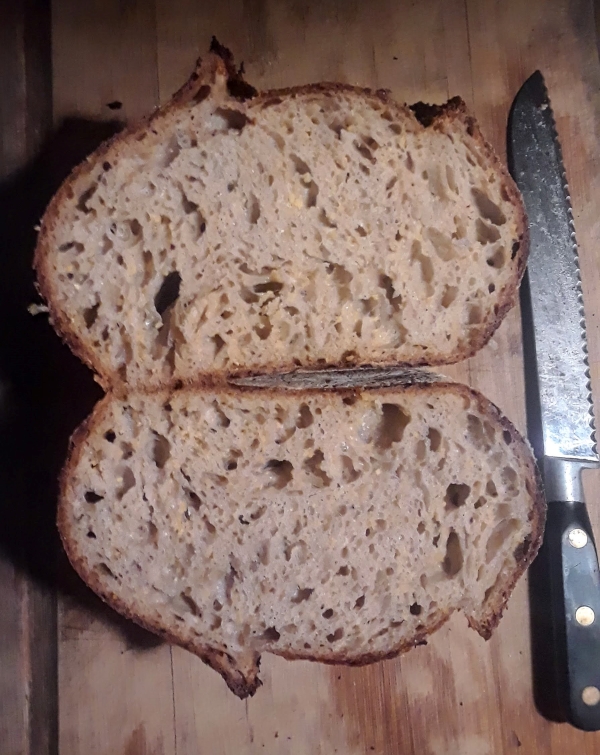
Polenta a la Benito

After taking a go at an olive polenta loaf a few weeks ago, I wanted to try the saccharification process highlighted by Benny in his loaf that's currently featured on the homepage. I didn't have diastatic malt powder on hand, so I used honey as it's supposed to also have amylase. The polenta definitely seemed a little sweeter after the process, but then again, I added honey to it, so it's a little hard to attribute the source of the change. Pretty straightforward approach otherwise.
350g (77%) Bread Flour
100g (23%) Bob's Red Mill Whole Wheat Flour
330g (73%) water
50g (11%) starter
---------------------
3 tsp salt
--------------------
45g Cateto Orange polenta from Red Tail Grains
150g water
= ~190g (42%) cooked polenta
--------------------
-Mix starter + water, dissolve, add all flour, mix. Let sit for 1 hr.
-pinch in salt
-over next 3 hrs. stretch and fold ever 30 min. (room temp. probably high 60s-low70s)
-after first 1.5 hrs. stretch out dough and spread polenta all over surface, fold up, continue stretch and folds
-finish bulk fermentation 7 hrs. at ~60 degrees
-shape, retard in refrigerator for around 10 hrs.
-Bake: 500 22min, uncovered 10min, 450 30min.
-----------------------
Result: This was one of my best porridge type loaves, yet I think. The fermentation seemed right about on point (thanks to the tip about corn accelerating fermentation) resulting in a nice oven spring and good crumb. The crust is good too. The flavor seems a little different than the previous polenta loaf I did, lending credence to the saccharification process perhaps. Using a bit lower % of polenta, the crumb was a nicer balance between airy and creamy. The polenta definitely adds a nice subtle flavor- not as distinct as barley, but more than oats.
I think having a substantial portion of the flour be whole wheat (perhaps even higher than this loaf) is nice as the bitterness of the hard red whole wheat is balanced by the sweetness of the polenta.



Comments
That is one handsome loaf John. The overall profile is really excellent as are the crumb and crust. You should get your hands on some diastatic malt, it is quite useful in other ways besides saccharification.
Benny
Thank you! And yes, I think I should. I made bagels a few weeks ago and now this. I just need to remember to look for it when I'm out at the good grocery store.
I’ve never seen it in any of our local grocery stores so ordered it from Amazon.
Benny
Looks great and agree that you nailed the fermentation!
If you don't have easy access to malt powder, I bought wheat and rye malt grains from a brewery store. I just crush them reasonable well and add to the mash during the saccharification process. Seems to work well.
That's interesting to know about. I also read that rye flour can be used, but I (sadly) don't have any on ha d currently, though I often do as it's one of my favorite grains.
I think rye flour does have more enzyme activity than other flours but you may need more of it to get the same affect as malted rye. I add as little as 0.5g to the mash. If you added more than that in rye flour, I would be worried about impacting the flavor of the mash. I like rye mashes, so no issues there. It just might be an issue if you didn’t want the rye flavor in the bread.
Ah, I see. I'm also a fan of rye flavor, so that would also probably not be an issue for me, but it does limit its applicability. Thanks for the insight!